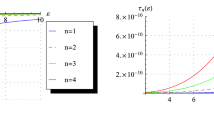Abstract
In this paper, a quantum dot mathematical model based on a two-dimensional Schrödinger equation assuming the 1/r inter-electronic potential is revisited. Generally, it is argued that the solutions of this model obtained by solving a biconfluent Heun equation have some limitations. The known polynomial solutions are confronted with new numerical calculations based on the Numerov method. A good qualitative agreement between them emerges. The numerical method being more general gives rise to new solutions. In particular, we are now able to calculate the quantum dot eigenfunctions for a much larger spectrum of external harmonic frequencies as compared to previous results. Also, the existence of bound state for such planar system, in the case ℓ = 0, is predicted and its respective eigenvalue is determined.




Similar content being viewed by others
References
S.M. Reimann, M. Manninen, Electronic structure of quantum dots. Rev. Mod. Phys. 74, 1283 (2002)
Ch. Sikorski, U. Merkt, Spectroscopy of electronic states in InSb quantum dots. Phys. Rev. Lett. 62, 2164 (1989)
U. Merkt, J. Huser, M. Wagner, Energy spectra of two electrons in a harmonic quantum dot. Phys. Rev. B. 43, 7320 (1991)
M. Taut, Two electrons in an external oscillator potential: Particular analytic solutions of a Coulomb correlation problem. Phys. Rev. A. 48, 3561 (1993)
A. Turbiner, Quantum mechanics: problems intermediate between exactly solvable and completely unsolvable. Sov. Phys. JETP. 67, 230 (1988)
A. Turbiner, Quasi-exactly-solvable problems and sl(2) algebra. Commun. Math. Phys. 118, 467 (1988)
A.G. Usheridze. Quasi-Exactly Solvable Models in Quantum Mechanics (Institute of Physics, Bristol, 1993)
F. Caruso, J. Martins, V. Oguri, Solving a two-electron quantum dot model in terms of polynomial solutions of a Biconfluent Heun equation. Ann. Phys. 347, 130 (2014)
F. Caruso, J. Martins, V. Oguri, F. Silveira, Corrigendum to ‘Solving a two-electron quantum dot model in terms of polynomial solutions of a Biconfluent Heun Equation’. Ann. Phys. 377, 518 (2017). [Ann. Phys. 347 (2014) 130–140]
M. Taut, Two electrons in a homogeneous magnetic field: particular analytical solutions. J. Phys. A. 27, 1045 (1994). and corrigendum J. Phys. A 27 4723 (1994)
M. Taut, Special analytical solutions of the Schrödinger equation for two and three electrons in a magnetic field and ad hoc generalizations to N particles. J. Phys.: Condens. Matter. 12, 3689 (2000)
M. Taut, H. Eschrig, Exact solutions for a two-electron quantum dot model in a magnetic field and application to more complex sytems. Z. Phys. Chem. 224, 631 (2010)
B.V. Numerov, A method of extrapolation of perturbations. Mon. Not. R. Astron. Soc. 84, 592 (1924)
B.V. Numerov, Note on the numerical integration of d 2 x/d t 2 = f(x,t). Astron. Nachr. 230, 359 (1927)
J.M. Blatt, Practical points concerning the solution of the Schrödinger equation. J. Comput. Phys. 1, 382 (1967)
A.C. Allison, The numerical solution of coupled differential equations arising from the Schrödinger equation. J. Comput. Phys. 6, 378 (1970)
J.P. Leroy, R. Wallace, Renormalized Numerov method applied to eigenvalue equations: extension to include single derivative terms and a variety of boundary conditions. J. Phys. Chem. 89, 1928 (1985)
F. Caruso, V. Oguri, Numerov numerical method applied to the Schrödinger equation. Rev. Bras. Ens. Fis. 36, 2310 (2014)
F. Caruso, J.A. Helayël-Neto, J. Martins, V. Oguri, Effects on the non-relativistic dynamics of a charged particle interacting with a Chern-Simons potential. Eur. Phys. J. B. 86, 324 (2013)
F. Caruso, V. Oguri, F. Silveira, How the inter-electronic potential Ansätze affect the bound state solutions of a planar two-electron quantum dot model. Phys. E 105, 182 (2019)
Author information
Authors and Affiliations
Corresponding author
Additional information
Publisher’s Note
Springer Nature remains neutral with regard to jurisdictional claims in published maps and institutional affiliations.
Rights and permissions
About this article
Cite this article
Caruso, F., Oguri, V. & Silveira, F. Numerical Solutions for a Two-dimensional Quantum Dot Model. Braz J Phys 49, 432–437 (2019). https://doi.org/10.1007/s13538-019-00656-7
Received:
Published:
Issue Date:
DOI: https://doi.org/10.1007/s13538-019-00656-7




